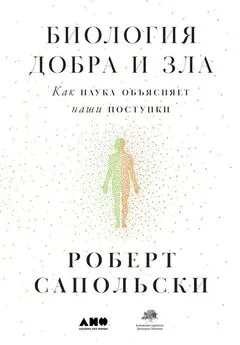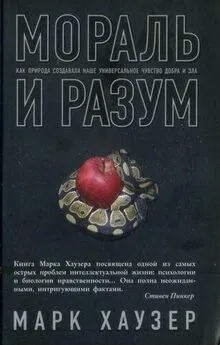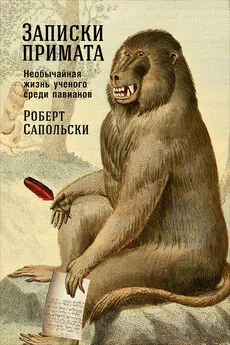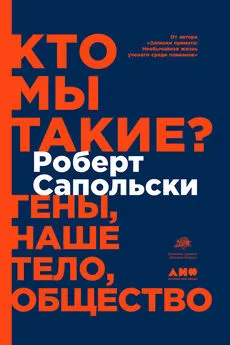Роберт Сапольски - Биология добра и зла. Как наука объясняет наши поступки
- Название:Биология добра и зла. Как наука объясняет наши поступки
- Автор:
- Жанр:
- Издательство:Альпина нон-фикшн
- Год:2019
- Город:Москва
- ISBN:978-5-0013-9051-0
- Рейтинг:
- Избранное:Добавить в избранное
-
Отзывы:
-
Ваша оценка:
Роберт Сапольски - Биология добра и зла. Как наука объясняет наши поступки краткое содержание
Биология добра и зла. Как наука объясняет наши поступки - читать онлайн бесплатно ознакомительный отрывок
Интервал:
Закладка:
724
S. Eidelman et al., “Low-Effort Thought Promotes Political Conservatism,” PSPB 38 (2012): 808; H. Thórisdóttir and J. T. Jost, “Motivated Closed-Mindedness Mediates the Effect of Threat on Political Conservatism,” Political Psych 32 (2011): 785.
725
B. Briers et al., “Hungry for Money: The Desire for Caloric Resources Increases the Desire for Financial Resources and Vice Versa,” Psych Sci 17 (2006): 939; S. Danziger et al., “Extraneous Factors in Judicial Decisions,” PNAS 108 (2011): 6889. Приведенное в тексте количество судебных решений взято из вышеупомянутой работы. C. Schein and K. Gray, “The Unifying Moral Dyad,” PSPB 41 (2015): 1147.
726
S. J. Thoma, “Estimating Gender Differences in the Comprehension and Preference of Moral Issues,” Developmental Rev 6 (1986): 165; S. J. Thoma, “Research on the Defining Issues Test,” in Handbook of Moral Development , ed. M. Killen and J. Smetana (New York: Psychology Press 2006), p. 67; N. Mahwa et al., “The Distinctiveness of Moral Judgment,” Educational Psych Rev 11 (1999): 361; E. Turiel, The Development of Social Knowledge: Morality and Convention (Cambridge: Cambridge University Press, 1983); N. Kuyel and R. J. Clover, “Moral Reasoning and Moral Orientation of U.S. and Turkish University Students,” Psych Rep 107 (2010): 463.
727
J. Haidt, “The New Synthesis in Moral Psychology,” Sci 316 (2007): 998; G. L. Baril and J. C. Wright, “Different Types of Moral Cognition: Moral Stages Versus Moral Foundations,” Personality and Individual Differences 53 (2012): 468.
728
N. Shook and R. Fazio, “Political Ideology, Exploration of Novel Stimuli, and Attitude Formation,” JESP 45 (2009): 995; M. D. Dodd et al., “The Political Left Rolls with the Good and the Political Right Confronts the Bad: Connecting Physiology and Cognition to Preferences,” Philosophical Transactions of the Royal Soc B 640 (2012) 640; K. Bulkeley, “Dream Content and Political Ideology,” Dreaming 12 (2002): 61; J. Vigil, “Political Leanings Vary with Facial Expression Processing and Psychosocial Functioning,” Group Processes & Intergroup Relations 13 (2011): 547; J. Jost et al., “Political Conservatism as Motivated Social Cognition,” Psych Bull 129 (2003): 339; L. Castelli and L. Carraro, “Ideology Is Related to Basic Cognitive Processes Involved in Attitude Formation,” JESP 47 (2011): 1013; L. Carraro et al., “Implicit and Explicit Illusory Correlation as a Function of Political Ideology,” PLoS ONE 9 (2014): e96312; J. R. Hibbing et al., “Differences in Negativity Bias Underlie Variations in Political Ideology,” BBS 37 (2014): 297.
729
Любопытный анализ взаимоотношения ранга, стабильности и избегания рисков, см.: J. Jordan et al., “Something to Lose and Nothing to Gain: The Role of Stress in the Interactive Effect of Power and Stability on Risk Taking,” Administrative Sci Quarterly 56 (2011): 530. Обсуждение: J. Jost et al., “Political Conservatism as Motivated Social Cognition,” Psych Bull 129 (2003): 339.
730
P. Nail et al., “Threat Causes Liberals to Think Like Conservatives,” JESP 45 (2009): 901; J. Greenberg et al., “The Causes and Consequences of the Need for Self-Esteem: A Terror Management Theory,” in Public Self and Private Self , ed. R. Baumeister (New York: Springer, 1986); T. Pyszczynski et al., “A Dual Process Model of Defense Against Conscious and Unconscious Death-Related Thoughts: An Extension of Terror Management Theory,” Psych Rev 106 (1999): 835.
731
J. L. Napier and J. T. Jost, “Why Are Conservatives Happier Than Liberals?” Psych Sci 19 (2008): 565.
732
J. Block and J. Block, “Nursery School Personality and Political Orientation Two Decades Later,” J Res in Personality 40 (2006): 734. Также см.: M. R. Tagar et al., “Heralding the Authoritarian? Orientation Toward Authority in Early Childhood,” Psych Sci 25 (2014): 883; R. C. Fraley et al., “Developmental Antecedents of Political Ideology: A Longitudinal Investigation from Birth to Age 18 Years,” Psych Sci 23 (2012): 1425.
733
Y. Inbar et al., “Disgusting Smells Cause Decreased Liking of Gay Men,” Emotion 12 (2012): 23; T. Adams et al., “Disgust and the Politics of Sex: Exposure to a Disgusting Odorant Increases Politically Conservative Views on Sex and Decreases Support for Gay Marriage,” PLoS ONE 9 (2014): e95572; H. A. Chapman and A. K. Anderson, “Things Rank and Gross in Nature: A Review and Synthesis of Moral Disgust,” Psych Bull 139 (2013): 300.
734
G. Hodson and K. Costello, “Interpersonal Disgust, Ideological Orientations, and Dehumanization as Predictors of Intergroup Attitudes,” Psych Sci 18 (2007): 691; K. Smith et al., “Disgust Sensitivity and the Neurophysiology of Left-Right Political Orientations,” PLoS ONE 6 (2011): e2552.
735
J. Lee et al., “Emotion Regulation as the Foundation of Political Attitudes: Does Reappraisal Decrease Support for Conservative Policies?” PLoS ONE 8 (2013): e83143; M. Feinberg et al., “Gut Check: Reappraisal of Disgust Helps Explain Liberal-Conservative Differences on Issues of Purity,” Emotion 14 (2014): 513.
736
J. Haidt, The Righteous Mind: Why Good People Are Divided by Politics and Religion (New York: Pantheon, 2012); L. Kass, “The Wisdom of Repugnance: Why We Should Ban the Cloning of Human Beings,” New Republic , June 2, 1997.
737
R. Kanai et al., “Political Orientations Are Correlated with Brain Structure in Young Adults,” Curr Biol 21 (2011): 677; D. Schreiber et al., “Red Brain, Blue Brain: Evaluative Processes Differ in Democrats and Republicans,” PLoS ONE 8 (2013): e52970; W. Ahn et al., “Nonpolitical Images Evoke Neural Predictors of Political Ideology,” Curr Biol 24 (2014): 2693. Общий обзор см. по: J. Hibbing et al., “The Deeper Source of Political Conflict: Evidence from the Psychological, Cognitive, and Neurosciences,” TICS 18 (2014): 111.
738
J. Settle et al., “Friendships Moderate an Association Between a Dopamine Gene Variant and Political Ideology,” J Politics 72 (2010): 1189; K. Smith et al., “linkhing Genetics and Political Attitudes: Reconceptualizing Political Ideology,” Political Psych 32 (2011): 369; L. Buchen, “The Anatomy of Politics,” Nat 490 (2012): 466.
Некоторые работы по политической ориентации и вовлеченности: двойное исследование – N. G. Martin et al., “Transmission of Social Attitudes,” PNAS 83 (1986): 4364; R. I. Lake et al., “Further Evidence Against the Environmental Transmission of Individual Differences in Neuroticism from a Collaborative Study of 45,850 Twins and Relatives on Two Continents,” Behav Genetics 30 (2000): 223; J. R. Alford et al., “Are Political Orientations Genetically Transmitted,” Am Political Sci Rev 99 (2005): 153; общегеномная связь – P. Hatemi et al., “A Genome-wide Analysis of Liberal and Conservative Political Attitudes,” J Politics 73 (2011): 1; D. Amodio et al., “Neurocognitive Correlates of Liberalism and Conservatism,” Nat Nsci 10 (2007): 1246.
739
T. Kameda and R Hastie, “Herd Behavior: Its Biological, Neural, Cognitive and Social Underpinnings,” in Emerging Trends in the Social and Behavioral Sciences , ed. R. Scott and S. Kosslyn (Hoboken, NJ: Wiley and Sons, 2015); H. Kelman, “Compliance, Identification, and Internalization: Three Processes of Attitude Change,” J Conflict Resolution 2 (1958): 51.
740
К сноске: B. O. McGonigle and M. Chalmers, “Are Monkeys Logical?” Nat 267 (1977): 694; D. J. Gillian, “Reasoning in the Chimpanzee: II. Transitive Inference,” J Exp Psych: Animal Behav Processes 7 (1981): 87; H. Davis, “Transitive Inference in Rats ( Rattus norvegicus ),” J Comparative Psych 106 (1992): 342; W. Roberts and M. Phelps, “Transitive Inference in Rats: A Test of the Spatial Coding Hypothesis,” Psych Sci 5 (1994): 368; L. von Fersen et al., “Transitive Inference Formation in Pigeons,” J Exp Psych: Animal Behav Processes 17 (1991): 334; J. Stern et al., “Transitive Inference in Pigeons: Simplified Procedures and a Test of Value Transfer Theory,” Animal Learning & Behav 23 (1995): 76; A. B. Bond et al., “Social Complexity and Transitive Inference in Corvids,” Animal Behav 65 (2003): 479; L. Grosenick et al., “Fish Can Infer Social Rank by Observation Alone,” Nat 445 (2007): 429.
741
C. Watson and C. Caldwell, “Neighbor Effects in Marmosets: Social Contagion of Agonism and Affiliation in Captive Callithrix jacchus ,” Am J Primat 72 (2010): 549; K. Baker and F. Aureli, “The Neighbor Effect: Other Groups Influence Intragroup Agonistic Behavior in Captive Chimpanzees,” Am J Primat 40 (1996): 283.
742
L. A. Dugatkin, “Animals Imitate, Too,” Sci Am 283 (2000): 67.
743
K. Bonnie et al., “Spread of Arbitrary Conventions Among Chimpanzees: A Controlled Experiment,” Proc Royal Soc of London B 274 (2007): 367; M. Dindo et al., “In-group Conformity Sustains Different Foraging Traditions in Capuchin Monkeys ( Cebus apella ),” PLoS ONE 4 (2009): e7858; D. Fragaszy and E. Visalberghi, “Socially Biased Learning in Monkeys,” Learning Behav 32 (2004): 24; L. Aplin et al., “Experimentally-Induced Innovations Lead to Persistent Culture via Conformity in Wild Birds,” Nat 518 (2014): 538. Исследование, в котором не удалось повторить основные открытия де Вааля: E. Van Leeuwen et al., “Chimpanzees ( Pan troglodytes ) Flexibly Adjust Their Behaviour in Order to Maximize Payoffs, Not to Conform to Majorities,” PLoS ONE 8 (2013): e80945.
744
E. van de Waal et al., “Potent Social Learning and Conformity Shape a Wild Primate’s Foraging Decisions,” Sci 340 (2013): 483.
745
A. Shestakova et al., “Electrophysiological Precursors of Social Conformity,” SCAN 8 (2013): 756.
746
H. Tajfel and J. C. Turner, “The Social Identity Theory of Intergroup Behaviour,” in Psychology of Intergroup Relations, ed. S. Worchel and W. G. Austin (Chicago IL: Nelson-Hall, 1986), pp. 7–24; E. A. Losin et al., “Own-Gender Imitation Activates the Brain’s Reward Circuitry,” SCAN 7 (2012): 804; R. Yu and S. Sun, “To Conform or Not to Conform: Spontaneous Conformity Diminishes the Sensitivity to Monetary Outcomes,” PLoS ONE 28 (2013): e64530.
Читать дальшеИнтервал:
Закладка:





![Роберт Сапольски - Игры тестостерона и другие вопросы биологии поведения [litres]](/books/1074102/robert-sapolski-igry-testosterona-i-drugie-vopros.webp)




